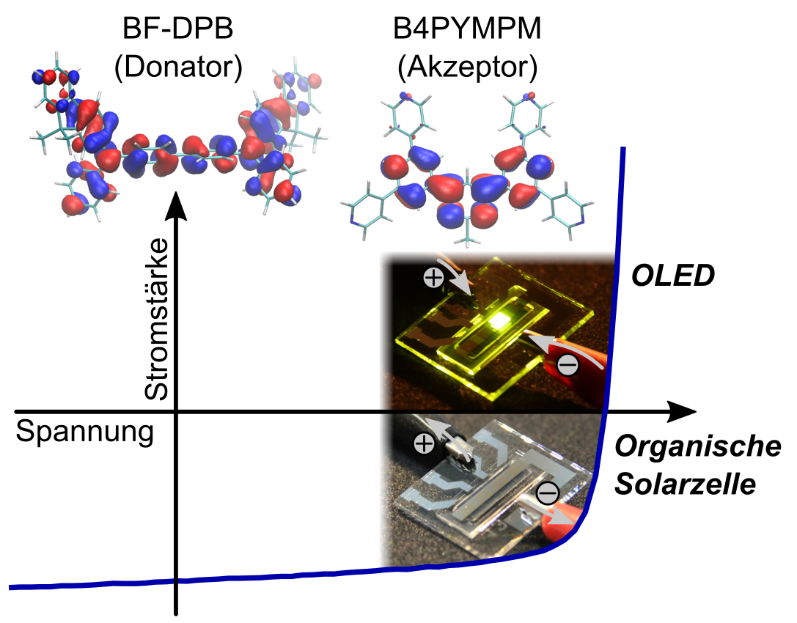Organic Solar Cells and Light-emitting Diodes United
In the past 25 years of research on organic semiconductors, it was thought that organic solar cells and organic light-emitting diodes (OLEDs) could not be combined in a single device. A team of physicists headed by Prof. Koen Vandewal from Technische Universität Dresden has now succeeded in manufacturing an organic solar cell that simultaneously functions as an efficient OLED. Their findings were recently published in the internationally renowned journal Nature Materials.
Image: Current-voltage characteristic of an organic optoelectronic diode that absorbs ultraviolet and blue photons. Below the open-circuit voltage the diode functions as a solar cell and above as an OLED. The molecular structures show the charge carrier distribution in the organic semiconductors used: BF-DPB (electron donor) and B4PYMPM (electron acceptor). Visualisation by Dr. Reinhard Scholz and Matteo Cucchi.
_______________
A fundamental loss mechanism in semiconductors is the emission of light to maintain the thermodynamic balance between the material and its environment. Precisely this balance between light absorption and light emission in semiconductors is responsible for the fact that "an ideal solar cell is also an ideal light-emitting diode," says Johannes Benduhn, reiterating the basic assumption by the Organic Solar Cells (OSOL) group at the Institute of Applied Physics.
However, organic solar cells are subject to further loss mechanisms which have challenged this assumption until now. Instead of generating light, a large part of charge carriers recombines in the form of heat ("non-radiative"). This leads to a lower voltage and consequently a reduction of the power conversion efficiency, one of the main reasons why organic solar cells are not as efficient as established technologies you can currently find on rooftops. With the newly developed organic solar cells, the OSOL Group was able to keep these voltage losses comparatively low and thus pave the way for higher efficiency and completely new fields of application.
The international research team has succeeded in developing combinations of organic semiconductors based on electron acceptor and electron donor heterojunctions that function as both solar cells and LEDs. The results of this research significantly extend the current understanding of organic semiconductors and combine the physical description of organic solar cells and OLEDs for the first time.
These findings will contribute to the development of more energy-efficient OLEDs in smartphone displays or television screens. The newly developed photovoltaic devices can be used for the efficient conversion of ultraviolet and blue photons into electrical power, e.g. in indoor applications for the electrical supply of Internet-of-Things devices or as semi-transparent solar cells in glass facades.
The Organic Solar Cell (OSOL) Group at TU Dresden’s Institute of Applied Physics
The OSOL group is part of the Dresden Integrated Center for Applied Physics and Photonic Materials (IAPP) and the Institute of Applied Physics of TU Dresden. The group was formerly headed by Prof. Koen Vandewal, who is now teaching and conducting research at the University of Hasselt in Belgium. One research focus of the OSOL group is photoactive organic semiconductors and their application in solar cells and photodetectors. They are currently conducting research on topics such as fundamental recombination processes, the development and synthesis of new materials, the design of new device architectures and the optimisation of organic solar cells.
Original Publication:
Sascha Ullbrich, Johannes Benduhn, Xiangkun Jia, Vasileios C. Nikolis, Kristofer Tvingstedt, Fortunato Piersimoni, Steffen Roland, Yuan Liu, Jinhan Wu, Axel Fischer, Dieter Neher, Sebastian Reineke, Donato Spoltore and Koen Vandewal, Emissive and charge-generating donor–acceptor interfaces for organic optoelectronics with low voltage losses. Nature Materials 2019 (https://doi.org/10.1038/s41563-019-0324-5)

